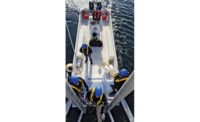One year after Japan's Fukushima Daichi nuclear powerplant suffered devastation and meltdowns after a powerful offshore earthquake and tsunami, the island nation is embracing more renewable power sources to offset its electricity mix.
The country is looking at offshore wind power to supply some energy generation off the coasts of the Fukushima and Ibaraki prefectures. Plus, the government is looking at the feasibility of floating wind farms.
Japanese trading company Marubeni said on March 6 that a consortium including Marubeni, Mitsubishi Heavy Industries, Mitsui Engineering and Shipbuilding, Shimizu Corp. and the University of Tokyo has won a contract from the Ministry of Economy, Trade and Industry (METI) to launch a feasibility study of a floating wind farm in Fukushima Bay.
The group reportedly will receive 12.5 billlion yen ($154 million) with the goal of building three floating wind turbines, one 2 MW and two 7 MW. It also will build a 6-kV floating wind transmission substation.
Prior to the tsunami, some 30% of Japan's electricity came from nuclear power, and the country already was testing other sources. For example, off the coast of Ibaraki, the prefecture that borders Fukushima to the south, Wind Power Kamisu's 14-MW, seven-turbine near-shore test facility is providing some much-needed power to the region. The company is now moving ahead with a 100-turbine facility.
Following the March 2011 accident, former Prime Minister Naoto Kan said Japan should move away from nuclear power and instead promote electricity production from renewable resources, such as biomass, wind and solar power. During a debate aired on Feb. 25 by Asahi Satellite Broadcasting, Yukio Edano, head of METI, said Japanese utilities will have to raise electricity rates by up to 15% as long as their nuclear powerplants remain shut.
Kan told Reuters last year that the fear of possibly needing to evacuate tens of millions of people from Tokyo following the Fukushima disaster convinced him that Japan needs to reduce its reliance on nuclear power by promoting renewable energy. But specific targets for onshore and offshore wind have not been decided, Komatsuzaki says.
The Kamisu wind farm began operating in June 2010 as Japan's first near-offshore wind farm. The 80-meter-blade wind turbines rest on monopile foundations anchored in the seabed outside the harbor. In May, the Kamisu wind farm is scheduled to begin phase two of its test by driving monopiles into the seabed for another eight wind turbines. Early-stage planning for the 100-turbine new energy megasite is expected to follow by next June, Komatsuzaki says.
Breaking precedent to build a wind farm in the open sea in Japan has been challenging on many fronts, Komatsuzaki says. "Regulations are strict, and dealing with coastal boundary zones to build large-scale turbines is difficult," he says. "But discussions with officials are progressing."



Post a comment to this article
Report Abusive Comment